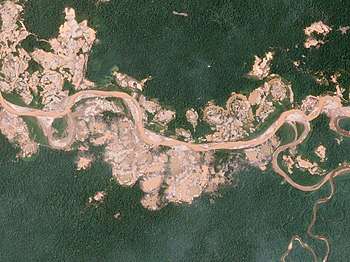Illegal mining
Illegal mining is mining activity that is undertaken without state permission, in particular in absence of land rights, mining licenses, and exploration or mineral transportation permits.[1]

Illegal mining can be a subsistence activity, as is the case with artisanal mining, or it can belong to large-scale organized crime,[2] spearheaded by illegal mining syndicates.[3][4] On an international level, approximately 80 percent of small-scale mining operations can be categorized as illegal.[5] Despite strategic developments towards "responsible mining," even big companies can be involved in (partially) illegal mineral digging and extraction, if only on the financing side.[6]
Regional Issues
Sub-Saharan Africa
Spurred by widespread poverty and a lack of alternative income-earning opportunities, illegal artisanal mining is a well-documented phenomenon in sub-Saharan Africa. While legalization opportunities for artisanal and small scale mining are often available, inefficient government bureaucracy structures can make noncompliance more appealing for workers. In addition, in an effort to attract foreign investment, many governments in sub-Saharan Africa have loosened national mining investment codes. An expansion of the large-scale mining projects fueled by foreign investment has displaced rural mining communities, many of which revert to illegal mining on concessions given to the formal mining sector.[7]
Latin America
Illegal gold mining in Latin America is a particular concern because of the scale of organized crime and significant rate of environmental degradation (through mercury and other toxic chemicals routinely used in gold mining) that accompany it.[3][4]
Illegal mining operations are often located in remote areas, making it more difficult to enforce mining standards. Furthermore, mining requirements can vary substantially from region to region, further complicating adherence with labor laws, environmental regulations, and tax legislation.[4] Emissions of mercury originating in artisanal mining, most of which is unregulated and illegal, are substantial, contributing to 37 percent of the atmospheric mercury emitted annually.[3]
While drug trafficking has historically been a prominent criminal enterprise, lower risks associated with illegal mining have propelled a shift toward lucrative illegal gold mining operations. In order to transfer illegal gold into the marketplace, criminal actors sometimes attempt to mask its illicit origins by melting together processed legal and illegal gold. This gold laundering task is generally facilitated by middlemen who falsify documentation to ease the transition into the legitimate international marketplace.[4]
See also
- Artisanal mining
- Blood diamond
- Bootleg mining
- Illegal mining in India
- Mining law
- Sand theft
References
- Dozolme, Philippe (2018). "Learn What Illegal Mining Operations Are". The Balance.
- Zabyelina, Y.; van Uhm, D.P. Illegal Mining: Organized Crime, Corruption, and Ecocide in a Resource-Scarce World. Palgrave.
- Sieber, Nancy; Brain, Joseph (2014). "Health Impact of Artisanal Gold Mining in Latin America". ReVista: Harvard Review of Latin America. Harvard University.
- Huerbsch, Brian; Spiro, Jesse (2016). "Illegal Mining in South America and Financial Risk - Taking the Shine off Gold" (PDF). Thomson Reuters: Risk Management Solutions. Thomson Reuters.
- Hentschel, T., Hruschka, F., Priester, M. (2003). "Artisanal and small-scale mining: challenges and opportunities". International Institute for Environment and Development, London. http://pubs.iied.org/9268IIED/.
- Castilla, Oscar; Amancio, Nelly; Lopez, Fabiola (2015). "The Companies Accused of Buying Latin America's Illegal Gold". InSight Crime.
- Banchirigah, Sadia. (2008). "Challenges with eradicating illegal mining in Ghana: A perspective from the grassroots". Resources Policy, 33(1), 29-38. https://doi.org/10.1016/j.resourpol.2007.11.001.